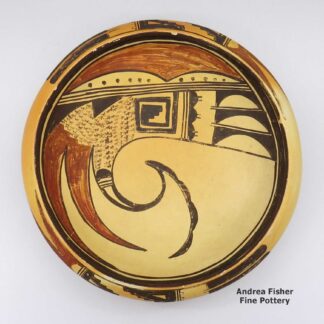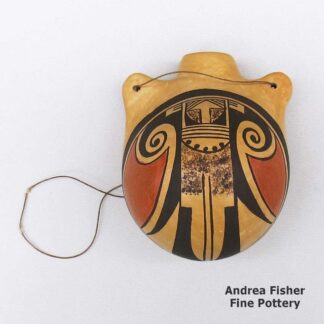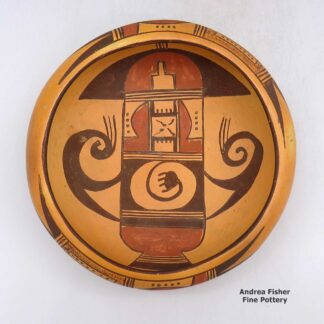Unknown Hopi Potter
The Nampeyo family were the first to begin signing their pots at Hopi, probably in the early 1920s. Nampeyo herself couldn’t do it but those who painted for her as she went blind could, and did. They realized the value of the name on the product.
In the late 1920s and early 1930s all Hopi potters were encouraged to develop hallmarks to signify their own pottery as opposed to everyone else’s. That worked until more potters learned how to write and could (and would) sign their names to their work.
In the old days, potters would make some mark to signify their pottery. Sometimes it was an extra coil around the rim, sometimes it was in the pattern of fingerprints inside the piece, sometimes it was a flourish in the design, sometimes it was a spout-like bend in the opening, sometimes it was in the tick marks on the rim…
Communal feasting developed among the Ancestral Puebloans as a means of incorporating newly arrived migrants into existing communities. That feasting was also usually “potluck.” That implies the members of each family at the feast knew the individual traits whereby their family’s pottery was identified and could simply walk up, pick it out and walk away with it. That’s how we still attribute unsigned pottery to individual potters: we look for recognized attributes and hallmarks in all aspects of a piece.
However, we only know so much and that information can take us only so far. There is a lot of Hopi pottery out there that can’t be attributed to any single potter.
Showing all 4 results
-

Unknown Hopi Artist, nuho2m083, Polychrome bowl with fire clouds and a geometric design
$850.00 Add to cart -

Unknown Hopi Artist, zzho3b529, Wall plaque with geometric design
$325.00 Add to cart -

Unknown Hopi Artist, zzho3b534, Canteen with a geometric design and string handle
$195.00 Add to cart -

Unknown Hopi Potter, zzho2j087, Polychrome bowl with design inside and out
$695.00 Add to cart
Showing all 4 results